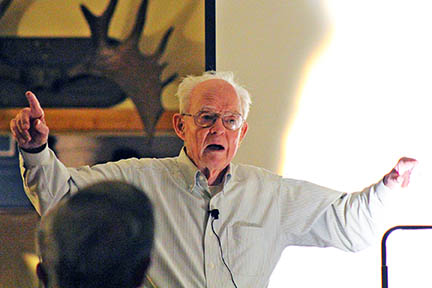NASA has named the first mission to fly a spacecraft directly into the sun’s atmosphere in honor of Prof. Eugene Parker, a pioneering physicist at the University of Chicago, and former resident of Homewood and Flossmoor.
Preserve in Homewood on Oct. 26, 2017. NASA
named a spacecraft after Parker to honor his
contributions to astrophysics. (Chronicle file photo)
NASA has named the first mission to fly a spacecraft directly into the sun’s atmosphere in honor of Prof. Eugene Parker, a pioneering physicist at the University of Chicago, and former resident of Homewood and Flossmoor.
The Parker Solar Probe will launch on or around July 31 on a mission to fly within 4 million miles of the sun’s surface to study the star with unprecedented precision.
Related story:
Parker is the S. Chandrasekhar Distinguished Service Professor Emeritus in Physics at the university. He is best known for developing the concept of solar wind — the stream of electrically charged particles emitted by the sun.
“This marks the first time a NASA spacecraft has been named for a living individual, and I am very excited to be personally involved,” said Thomas Zurbuchen, associate administrator for NASA’s Science Mission Directorate in Washington, D.C. “Gene Parker has been an inspiration to an entire generation of scientists, including me. Having his name on humanity’s first mission to a star is a fitting legacy.”
In 2017, Zurbuchen presented Parker with NASA’s distinguished public service medal, one of its highest honors.
During the course of 24 orbits, the Parker Solar Probe spacecraft will fly by Venus seven times to gravitationally reduce its distance from the sun. Three of the spacecraft’s orbits will bring it within 3.9 million miles of the sun’s surface—approximately seven times closer than any other probe. The solar probe, built by the Applied Physics Laboratory, will endure a solar intensity more than 500 times greater than that of an Earth-orbiting spacecraft.
“The solar probe is going to a region of space that has never been explored before. It’s very exciting that we’ll finally get a look,” said Parker, who was on the UChicago faculty from 1955 to 1995. “One would like to have some more detailed measurements of what’s going on in the solar wind. I’m sure that there will be some surprises. There always are.”
Parker explains that although he first predicted the solar wind in 1957, “it wasn’t so much a prediction as a recognition that it was there.”
Parker’s early work laid the groundwork for his landmark discovery. He was a research associate beginning in 1953 at the University of Utah under Walter Elsasser, who pioneered the dynamo theory of the origin of Earth’s magnetic field. In 1955, John Simpson, a veteran of the Manhattan Project, recruited Parker to UChicago to study cosmic rays.
At that time scientists knew, based on the work of Peter Biermann and Cuno Hoffmeister, that the gaseous tails of comets, which always point away from the sun, are swept away by some form of solar particle emission. Scientists thought of these solar emission particles as being shot from the sun — much like cannon balls from cannons. Parker, however, came to see the process as a flow of gas that is subject to the simple laws of hydrodynamics, becoming what he called the solar wind.
The first paper Parker submitted to the Astrophysical Journal proposing the solar wind was panned by two eminent reviewers. Parker pointed out to Chandrasekhar, who was the journal’s editor at the time, that neither reviewer had flagged any mathematical flaws in the work, and the paper was published in 1958.
“Chandra told me many years later that he was very skeptical about it, but since he couldn’t find anything wrong with the math, he figured it was worth thinking about,” Parker said.
The results were verified in 1962 with data collected by the Mariner II space probe to Venus, the first successful interplanetary mission. Understanding solar wind made it possible to expound the causes of magnetic storms, auroras and other solar-terrestrial phenomena.
After his work on the solar wind, Parker became interested in the magnetic fields of galaxies. This led to his discovery of a phenomenon now called the Parker Instability, which explains why there are places where the magnetic field bulges from the disk of a galaxy.
Parker, who is author of “Cosmical Magnetic Fields — Their Origin and Activity,” was elected to the National Academy of Sciences in 1967. He received the National Medal of Science, the nation’s highest scientific honor, in 1989. He also received the 2003 Kyoto Prize for Lifetime Achievements for Basic Science.


